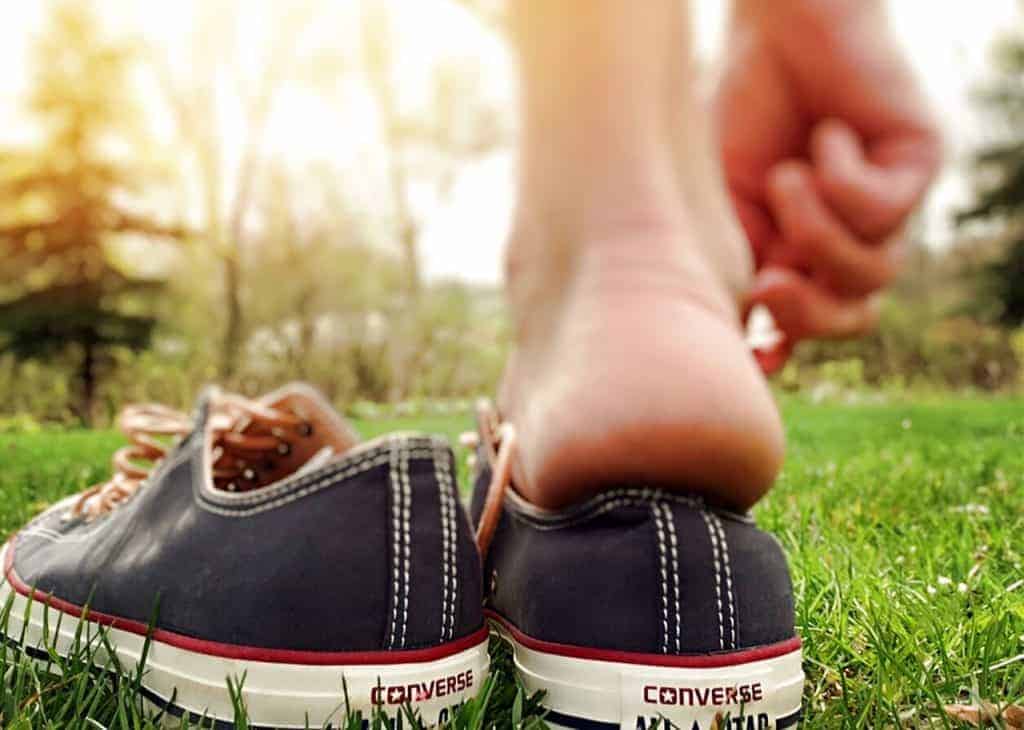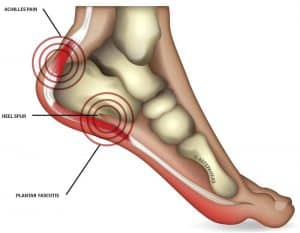
Blog, Heel Pain

Think you have a heel spur? Think again
There’s a myriad mystery and misinformation about heel spurs. Just the thought alone of having a hard protruding growth on the bottom of the heel is more than a little alarming — but really, it needn’t be.
What is a heel spur?
“A heel spur is a small bony growth at the underside of the heel bone. People call it a spur or a calcification. We might also call it an exostosis (a benign outgrowth of cartilaginous tissue),” explains sports podiatrist and founder of A Step Ahead Foot + Ankle Care Dr Brenden Brown.
“Heel spurs are incredibly common. I see it in about 40-50% of the x-rays I perform. “However, the vast majority of people with heel spurs experience NO PAIN whatsoever.
“In all of the time I have been a podiatrist (which is 20 plus years) I have seen two symptomatic heel spurs. I’ve seen lots of heel spurs but only two that have ever presented with associated pain.
“So if we talk about the signs of symptoms of heel spurs there aren’t really any apart from having a large bony or hard nodule on the underside of the heel pad that doesn’t feel the same as the other foot and cannot be depressed (pushed or squashed).
“99% of people who come to me saying they have pain from a heel spur do not have pain as a result of a spur.
“A heel spur won’t bother you unless it’s prominent beneath your foot and the orientation of the spur is angled more towards the ground; this could cause some pain and discomfort. However, I’ve read about these types of spurs but I’ve never even seen one. Not in 20 years of practicing.”

5 heel spur facts
- Your pain is most likely not caused by a heel spur
The vast array of people with heel spurs have NEVER HAD A DAY OF PAIN in their life
- Heel spur pain doesn’t come and go like a yo-yo
In those very rare cases where people do have a heel spur that’s causing them pain—the pain doesn’t come and go.
“If you have a friend who tells you they had a heel spur and the pain went away you have to ask yourself ‘where did that pain go?’ The pain of a heel spur isn’t like the cast of Neighbours – it doesn’t travel from Melbourne to Queensland to get a job and never return!”
- Silica won’t cure a heel spur
“People have told me they took silica and it miraculously dissolves their spur. I have to ask these patients ‘how on earth did the silica dissolve your bony spur but manage to leave the rest of the foot in tact. How did it not also dissolve the frontal lobe of your skull?”
- No operation needed
Even if you do have a heel spur, which most of the time is an incidental finding on an x-ray, you don’t need an operation to remove it.
- Cortisone won’t help your heel pain
For most people cortisone is useless in treating heel pain. In fact, studies have shown that after three months 56% of people who were having cortisone injections for their heel pain had zero reduction in pain.
If it’s not a heel spur — what is causing my pain?
Heel pain can be caused by a variety of other reasons including: plantar fasciitis, plantar fasciosis, abductor hallucis strain or tibialis posterior tendinosis.
If you are suffering from heel pain, be sure to visit your local podiatrist but don’t be fooled into automatically thinking that it’s a heel spur—it’s highly likely that it’s not!
Related articles:
10 things you should know about heel pain
A Step Ahead Foot + Ankle Care is one of Sydney’s leading foot and ankle clinics. Principal podiatrist and founder of A Step Ahead Dr Brenden Brown (AKA Dr Foot) has been taking care of people’s feet for more than 20 years.
With a background in sports medicine and having served as a former president of the Australasian Podiatry Council, Brenden is a wealth of information when it comes to foot and ankle care.
Got a question? Check out our Instagram profile #AskDrFoot
Or, tune into our Facebook page for regular live videos and updates on the latest foot and ankle advice from the experts.

Blog, Kids Feet, Uncategorized

Taking care of common kids’ foot complaints
While most parents worry about the health of their child’s eyes and teeth, many overlook the state of their kids’ feet. Feet are amazing; not only do they enable us to stand tall and move, they support our body weight and act as shock absorbers, in turn protecting our ankles, knees, hips and spine.
In young children the foot is pliable to allow it to develop, which means taking care of feet during the first few years of a child’s life is vital.
Recognising common foot complaints can help ensure that action is taken to address the problem and ensure your child’s feet continue to develop in a healthy way.

Ingrown toenails
Ingrown toenails are common with multiple causes. Widespread causes can include clipping the nails too short, cutting or picking at the edges of the nail, trauma to the nail due to kicking sports, excessively sweaty feet and pressure from footwear. All of these events can create a sharp edge on the nail, which can pierce the skin and lead to an ingrown toenail.
The symptoms of an ingrown toenail (onychocrytosis) can include a sore toe, pain at one side of the toenail and, in severe cases, a pus-filled discharge. In most cases it’s usually the big toe that’s affected.
Closed-toe shoes are likely to increase the intensity of the pain and, if left untreated, it’s common for the toenail to become infected making it difficult to walk and particularly painful to play sport.
To treat an ingrown toenail start by soaking the foot daily in warm, salty water, gently patting dry and applying a topical antiseptic. If possible, refrain from wearing enclosed shoes.
If the issue does not resolve within a couple of days it may require treatment by a podiatrist. This is a simple procedure that involves removing the small, sharp portion of nail causing the grief and dressing the nail to protect against infection. It usually takes minutes.
In acute cases nail surgery may be required.

Flat feet
In infants flat feet is common because they have a fat pad under the foot that hides the developing arch. By about the age of eight, the foot arch becomes apparent. Yet some children never develop an arch and this is called ‘flat feet’.
Flat feet or pronated feet (foot and ankle roll inwards) can be hereditary or due to muscle length and tone. In some instances the condition causes no pain or discomfort but in other cases flat feet or over pronated feet can cause pain in multiple areas of the body including the foot itself, shins, knees, lower back and Achilles tendons.
A podiatrist can help treat flat feet using orthotics, which hold the feet in their correct position and help relieve the associated pain. A detailed biomechanical analysis is conducted to diagnose which type of orthotics is best (there are many!).
In addition to orthotics, a podiatrist can advise on other measures that can be taken as part of a multi-pronged treatment plan. This may include stretching, strengthening exercises or deep connective tissue massage. Bare in mind that being overweight or wearing poor footwear can contribute to the symptoms of flat feet.
Plantar warts
Warts can be the bane of a parent’s life because they are so easy to contract, yet notoriously difficult to get rid of.
Often mistaken for corns, plantar warts appear as small (less than 5mm) rough, flat bumps on the bottom of the foot—usually on the underside of the toes, heel or forefoot. Some plantar warts have little black dots in the centre. This is caused by small blood vessels.
Warts are the result of a virus, so they are easily transferred to other children and adults and are particularly common in swimming pools, gyms, communal showers and other places that involve water, warmth and bare feet.
There’s a plethora of treatments for plantar warts but many are lengthy and not always successful. If over-the-counter non-prescription medicines don’t work, you can try a prescription medication such as salicylic acid or cryotherapy, which involves freezing the wart with liquid nitrogen.
Alternatively, your local podiatrist can use laser treatment or a small instrument to remove the wart. To prevent future plantar warts, avoid letting your child go barefoot in high-risk places such as public showers and outdoor swimming pools.
Want to know more about taking care of kids’ feet? Visit: mykidsfootdoctor.com.au.
Got a question? Ask Dr Foot
A Step Ahead Foot + Ankle Care is one of Sydney’s leading foot and ankle clinics. Principal podiatrist and founder of A Step Ahead Dr Brenden Brown (AKA Dr Foot) has been taking care of people’s feet for more than 20 years. With a background in sports medicine and having served as a former president of the Australasian Podiatry Council, Brenden is a wealth of information when it comes to foot and ankle care.
Related blogs:
Does your child need to see a podiatrist?
Are growing pains causing your child discomfort?











 Dr Brenden’s White paper report on the “6 Reasons You Won’t Beat Heal Pain” outlines what’s stopping you from beating this and tips on how to stop it in its tracks!
Dr Brenden’s White paper report on the “6 Reasons You Won’t Beat Heal Pain” outlines what’s stopping you from beating this and tips on how to stop it in its tracks!